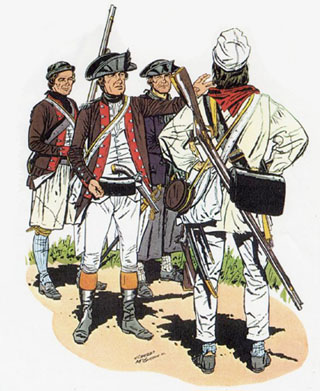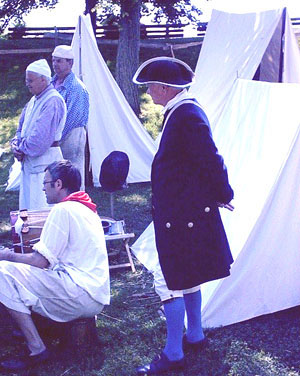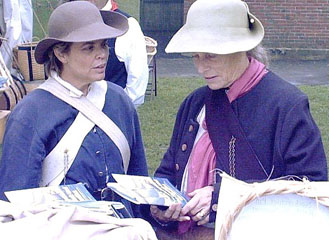
 |
|
||||||||||||||||
| |
|
|
|
|
|
|
|
|
|
|
|
|
|
|
|
|
|
| |
|
|
|
|
|
|
|||||||||||
| |
|
||||||||||||||||
| |
|
||||||||||||||||
 |
|
| Men: Outfitting and Equipment | |
| Men,
women and children in Glover's Marblehead Regiment (GMR) dress themselves
according to the characters they've chosen, using the historical record
(as well as many online and text resources) to guide them. To assist in outfitting, Glovers maintains a "slops chest" from which one can temporarily borrow various articles of clothing and accoutrements. Members new to Glovers often take advantage of the collection until they are able to purchase or make their own clothing and accoutrements. The typical loan term is about three months. (If you wish to explore our GMR slops chest, please contact Francie King at 781-631-5967 or E-mail to fbking@comcast.net.) Assembling an authentic re-enactment "kit" (as it is called) is part of the educational process. It is also an excellent way to become familiar with many aspects of American Revolutionary War maritime history, camp life, and community roles and relations. The hobby is blessed with many excellent provisioners and sources of clothing and goods � including tents, eating utensils and soldiers' and sailors' gear � which are available on-line and by mail. For a good list of 18th century merchants (called "sutlers") who can provision the reenactor from head to toe, click here. Many of these merchants also appear at reenacting events, with full shops and plenty of stock. |

|
 |
Women:
Provisioning and Attire One of the best resources on 18th century women's clothing can be found at Rhondda McCannon's web site at 18cnewenglandlife.org. This site will also help with men's as well as children's clothing. It lists many other sources of information and educational groups. Other good resource books for women include: • Whatever Shall I Wear by Mara Riley • Belonging to the Army by Holly Mayer • So Ye Want to be a Re-enactor? by Brent & Karen Kemmer • Tidings from the 18th Century by Beth Gilgun • Remember The Ladies, Women in America 1750-1815 by Linda Grant De Pauw and Conover Hunt • Liberty's Daughters, The Revolutionary Experience of American Women 1750-1800 by Mary Beth Norton Women • Campfollowers of the American Revolution by Walter Hart Blumenthal • Working Dress in Colonial and Revolutionary America by Peter F. Copeland You may want to check our Sutlers lists as well. |
| Fire Arms Safety | ||
| With
regard to firearms -- and the traditional 18th century black powder muskets
and blunderbusses -- most members of GMR own and carry their own firelocks
onto the event field. The Regiment places extremely high importance on firearm
safety and urges every musket-carrying member to undergo formal training
in hunter safety. With few exceptions, Glovers members have taken the State of Massachusetts Division of Fish and Wildlife hunter safety course (www.mass.gov/dfwele/dfw/dfwhecl.htm), the successful completion of which results in the Class A license to carry. For a good guide on black powder safety, see the website of the Continental Line (click here) and its excellent manual, "The Safety Standards and Guide to Black Powder." |
|